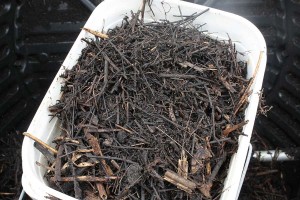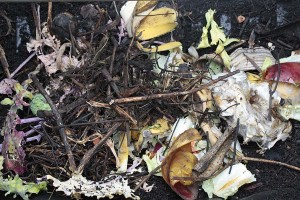This is a quick update on the composter I picked up back in early May. Was eight weeks enough time during a cool spring to create a batch of usable compost? I wondered.
Yes and no seems to be the answer. When to empty a compost pile or bin is always a balancing act. The most ephemeral scraps have long passed the point where they’re most beneficial. At the same time, the woodier clippings are only partially on their way to being ideal compost. You can screen the compost and use what will go through a half-inch screen. Or you can take the lazy way out and dump out most of what you have and pick out the egregiously big chunks for further breaking down.
I opted for the lazy/impatient method. A couple weeks ago the pile had started to cool down, and I didn’t want to keep feeding the pile more scraps, only to have to wait additional weeks to empty it. In total I netted about twenty gallons of gorgeously earthy-smelling black gold. I’m not sure how much I fed the composter, though I know I came close to filling up the 80-gallon contraption at least twice, only to have the clippings compact as they broke down.
I emptied the buckets around various veggie plantings around the yard. At this point the compost will serve as mulch, with some of the nutrition leaching into soil as the beds get watered. When it’s time for the late summer changeover of crops the mulch will get worked into the soil and serve more as an amendment. By that time I hope some of the bigger, crunchier bits of yard waste will have broken down even further.
If you want fine compost to mix into planting mix or to start seeds, you’ll want it broken down further than this, or you’d break out a screen to take out the bigger chunks. But for how I used the compost, this approach seems like it’ll work just fine.
Once I emptied the composter it was time to start the next batch, mixing some of the leftover scraps from the last batch with the new materials. I kinduv liked this photo with it perky colors and many layers. (I think it’s worth clicking on to expand.) Still I’m not the first one to turn a camera on a compost pile: I linked back in December of 2007 to Very Rich Hours of a Compost Pile, a photo project by John Pfahl. It’s worth a look.
Facing an empty bin I suddenly felt the urge to do some tidying around the garden if it meant that I’d be generating yard wast that I could feed the composter. Stop number one: one of the towers of Echium wildprettii that had collapsed spectacularly over a walkway and against the side of the house as it reached the end of its blooming. I’d lived a couple of weeks with the plant in this condition, stepping over it as I went back to my studio. But it was time. To avoid being inundated with hundreds of baby echiums, however, I only clipped the lower part of the plant for my bin. The top, with its myriad seeds is now in the greens recycle bin, on its way to the city recycling facility. The city facility caught fire in the 1990s from the high heat in their compost pile, so I have no doubt their facility will be able to break down seeds like this.
Overall, this has been a composter: it generates no unpleasant odors, and being a tumbling model it’s even fun to turn the drum a few revolutions to keep the clippings mixed. The last few days have actually been warmer, so I’m hoping the next batch will cook even quicker than the first.





Well, I’ve been photographing compost since before 2007…but never dared to publish. Now I have a cohort.
Sounds as if you got good value out of this composter. I’m a lazy/impatient composter myself, so I appreciated your reports on that method.
And yes, your compost picture definitely looks even better enlarged. To me, things like compost or dead leaves are abstract art waiting to happen.
I’m not so sure about those very rich hours, but you have some nice looking compost. How’s that for a pick up line, eh. I’ve always wanted to plant a E. wildprettii for a client but your photo of it flopping seems like a good reason not to. Seems like one of those plants you have to pick out for yourself, rather than have someone pick it out for you. I may need to plant one in my own garden someday, now that I think of it.
“Hey, baby, want to check out my compost? I promise you, it’s hella stinky!” 😉
Sorry I’ve been absent from your great site, James. I owe you a visit to all your posts, and will do so. I have never spent a wasted moment here, buddy. I’ve just been doing other stuff. I loved this, by the way, Keep us posted on your composting! It’s riveting entertainment and great for pick-up lines, too.
I keep composting and not getting any out. I’m afraid there are baby animals living in the midst of my huge messy pile. It serves as a place to lower my carbon footprint – food scraps on landfill are bad news, I recently learned. I also send seedy things to the landfill compost program trusting that they do compost to high temps and will kill them. I don’t inquire though. It’s too convenient to send them off. Reminds me of the saying – there is no more “out” (where you can throw things!).
I like your composter much better than mine. I bought one of those stationary compost bins (the kind you have to open the lid to manually turn over all the stuff inside) and it has not produced any usable good stuff for the two years I’ve had it. I’m about to throw in the hat and just buy a tumbler. The close-up of that compost pile of yours was pretty intriguing – kinda like a confounding Rorschach test for the OCD gardener.
Pomona, composting is a beautiful process. I’m glad you’re celebrating it in pictures too. I think humans need to feed their sense of play, and for me this tumbling contraption I have is still a hoot to use. It doesn’t hurt that magical black compost comes out the back end of the process.
Ryan, you might be on to something there with the pickup line: I always get weak knees when someone flatters my compost. I looked at the echium photos on the Dave’s Garden site and one of them alluded to how hard it was to find plants that hadn’t fallen over. They seem to grow in rocky, decomposing volcanic soil in the wilds, so I wonder if common garden soil just doesn’t provide them the support they’re used to.
Steve, good hearing from you. No worries on being away–I’m sure you’ve got some exciting things cooking at this point! To think some people confused this for a gardening blog when it’s really one about new pickup lines…
CM, even if you’re not harvesting compost from it, your greens pile is a major improvement to just tossing the scraps. Decomposing stuff in landfills is definitely a methane generator–not good news for the planet. As much as think the city landfill is doing a better job of composting than I am, I’m still reluctant to go there for the free mulch and inexpensive compost. Potential weed seeds bother me, but so does not knowing what tainted scraps people have tossed into their greens bin.
Arleen, the stationary models can work, but they’re definitely lots more work to keep turned. Now that I’ve purchased my tumbler I’ve been noticing similar models around. Most seem lower to the ground, potentially harder to turn, and definitely more difficult to empty once the compost is ready. Another model was a sphere that you could roll to wherever in the garden you wanted the compost, meaning you didn’t have to transfer the compost to a bucket. But that solution wouldn’t work on my multi-level yard.